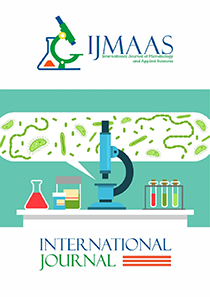Impact of Different Concentrations of Swine Wastewater on Bacterial Population and Physicochemical Properties of Soil
Vol. 4, Issue 1, 2025
KEYWORDS
Swine wastewater, Bacteria, Soil, Moisture content, Organic Matter, Carbon-Nitrogen Ratio.
Abstract
This study evaluated the effects of swine wastewater (SWW) on bacteria communities and physicochemical properties of soil over 21 days, with assessments conducted at 7-day intervals. Soil samples were collected from a 0–15 cm depth at the Rivers State University School Farm, Port Harcourt, Nigeria using a sterile hand auger while SWW was collected from the university piggery farm. Collected samples were aseptically transported to the laboratory in an ice-packed cooler. Microbiological and physicochemical analyses of the samples were conducted using standard procedures to ensure accuracy and reliability. The study revealed significant effects of SWW on both microbial and physicochemical properties of the soil. Bacterial counts increased notably with SWW application, peaking at 4.5 × 105CFU/g in the Soil + 20 ml SWW treatment on Day 14, before declining to 4.0 × 105 CFU/g by Day 21. Eleven bacterial genera were identified, including Lactobacillus, Streptococcus, Escherichia, Klebsiella, Staphylococcus, Bacillus, Pseudomonas, Enterobacter, Proteus, Salmonella, and Shigella. Physicochemical parameters showed marked changes in response to SWW application. Soil pH fluctuated, with the lowest value (6.09) recorded in the 100 ml SWW treatment on Day 21 and the highest (7.35) in the 40 ml SWW treatment on Day 7. Soil temperature increased with SWW application, peaking at 28.7°C in the 20 ml SWW treatment, compared to the control’s 25.4°C. Moisture content ranged from 11.39% in the control on Day 7 to 17.15% in the 40 ml SWW treatment. Organic matter content was lowest in the control with a value of 3.36% on Day 7 and highest (3.83%) in the 100 ml SWW treatment. Nitrogen levels fluctuated, with the control having the highest content (1.7%) on Day 7 and the 40 ml SWW treatment the lowest (0.6%). The carbon-to-nitrogen ratio ranged from 1.15 in the control to 3.38 in the 40 ml SWW treatment. In conclusion, SWW significantly influenced soil microbial activity and physicochemical characteristics, demonstrating its potential as a soil amendment. However, careful management of SWW applications is critical to avoid adverse effects on soil health, and disruption in balance of microbial populations, and to ensure sustainable soil fertility.
Current: Vol. 4, Issue 1, 2025

Call for papers
The International Journal of Microbiology and Applied Sciences warmly welcome your valuable articles for publication.
